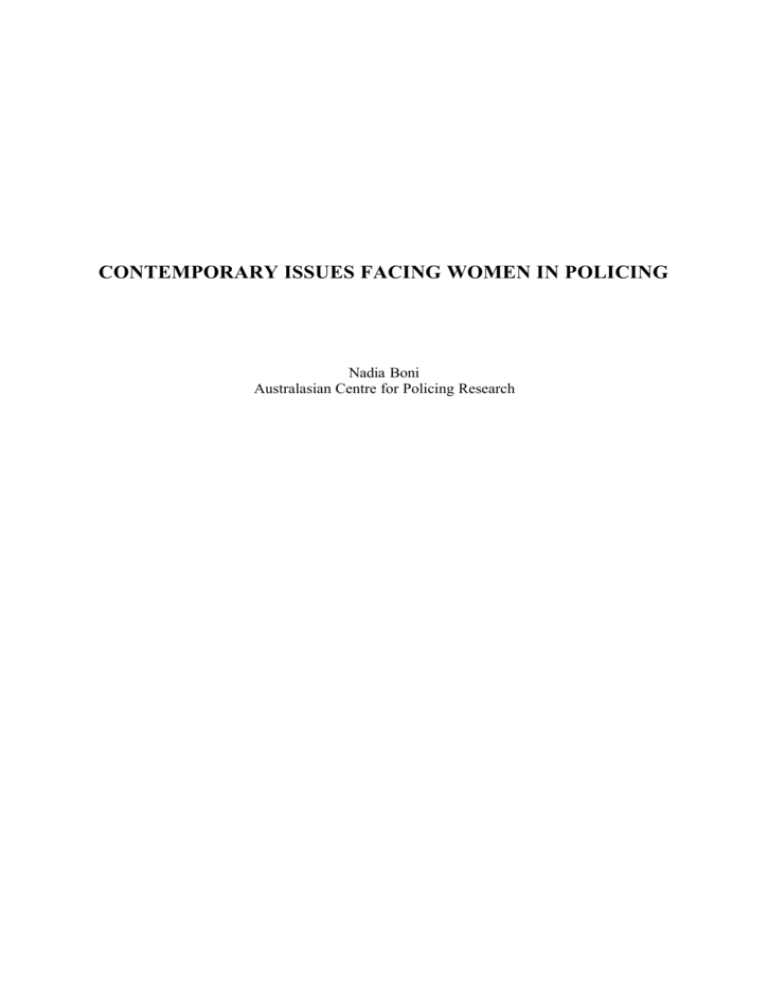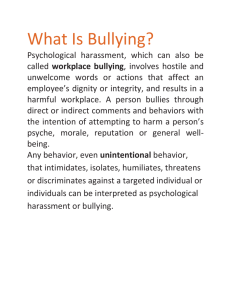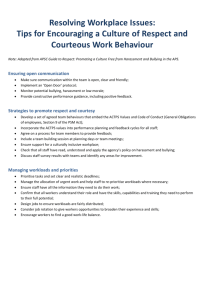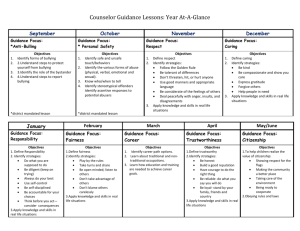
CONTEMPORARY ISSUES FACING WOMEN IN POLICING
Nadia Boni
Australasian Centre for Policing Research
Introduction
The importance of effective diversity management in policing has only relatively recently been the
subject of close academic scrutiny. Earlier research, mainly from the United States, largely dealt
with operational performance issues (Martin & Jurik, 1996) and matters such as the capability of
female officers (Brown & Neville, 1996; Coffey, Brown, & Savage, 1992) have continued to attract
research attention. Research on issues concerning equal employment opportunities (Brown &
Campbell, 1991; Prenzler, 1995), sexual harassment (Sutton, 1995), deployment (Boni, 1998) and
bullying (Rayner, 1997) has only come to the fore in more recent years. Many of the studies on
these issues have focused exclusively on women, and sworn women in particular. This leaves
unanswered questions about the relative impact of various issues on policemen, nonsworn men and
nonsworn women in police agencies.
Today I would like to present some findings from one of several studies undertaken by the
Australasian Centre for Policing Research (ACPR) that examine the general issue of organisational
problems and issues facing women in policing. This study also examines how these same
organisational issues impact on policemen, as well as on nonsworn male and female employees.
The findings presented today build on the knowledge about women in policing presented in a series
of related reports produced by the ACPR. These reports address the Educational and Professional
Development Experiences of Female and Male Police Employees (Boni, Adams, & Circelli, 2001)
and Women in Senior Police Management (Adams, 2001).
To start with I would like to give you some details of the background to the study and the general
methodology used. Then I will describe the survey instrument and examine two sets of findings
obtained, in particular, those that relate to career barriers and bullying. Finally I will examine the
implications of these findings for policing.
Research Background and Method
In October 1996, the Australasian Police Ministers’ Council asked the ACPR to undertake research
to assess the range of issues and problems facing women in policing. Accordingly, we developed a
survey, entitled Experiences in the Workplace which consists of a number of standardised measures
of work experiences and attitudes as well as a number of other items designed to measure issues
including deployment, and educational and personal development needs.
The survey was piloted with 900 Queensland Police Service employees and was then administered
to approximately 5,500 male and female, sworn and nonsworn police employees in 5 jurisdictions
in 1999. A 41% response rate was obtained which is quite a good result for a survey of this nature,
which is lengthy and deals with some sensitive issues (e.g., harassment, discrimination).
As mentioned above, the survey incorporates a range of measures of work attitudes and behaviours.
A previous ACPR report (Boni et al., 2001) discusses the findings of measures that relate to access
to professional education, development and training. The results I am presenting today are from a
more recent report (Boni & Circelli, in press) which focuses on the following issues:
Career Perceptions
•
Job intentions
•
Self-efficacy
Workplace Justice and Equity
•
Procedural justice
•
Distributive justice
•
Gender and transfer/deployment
2
•
Sexism
Organisational Impediments
•
Career barriers
•
Stressors
•
Compromises and sacrifices
•
Bullying
Workgroup Inter-Relations
•
Support groups and mentors
•
Co-worker support
•
Co-worker reaction to promotion
Given the time constraints, today I will discuss the results of only two of these issues, namely career
barriers and bullying. Workplace bullying, in particular, is an extremely topical issue at the
moment. While there are a vast number of international studies of bullying in the school and
childcare arena (e.g., Farrell, 1999; Griffiths, 1993; Jarvis & Berry, 1998; Rigby, 1998), studies of
bullying in Australian workplaces have been limited (Barron, 1998) and this is particularly true in
the case of police organisations. In response to this, the ACPR has recently produced a critical
issues paper that discusses workplace bullying, its prevalence, potential causes, consequences and
implications for policing (Lynch, 2002). A proposal for further research into bullying in the police
workplace has also been prepared.
Career Barriers
A standardised measure of career barriers developed by Simpson (1997) was used in the survey.
This measure assesses the degree to which cultural or attitudinal barriers at the organisational level
impede employees in their careers. There are 14 items. Respondents are asked to indicate the extent
to which each of the items has been a barrier to their career during the previous 12 months using a
6-point response scale, where 1=not at all, and 6= to a very large extent. Examples of some of the
items include 'family commitments', 'lack of career guidance', and 'sexual discrimination'.
The following emerged as the most significant career barriers for the entire sample:
•
lack of training;
•
attitudes of senior staff;
•
lack of career guidance; and
•
family commitments.
It is important to bear in mind that the means were low, indicating that overall these were
considered barriers to a little or a very little extent.
Significant gender differences also emerged. Women rated the following barriers more highly than
did men:
•
lack of adequate childcare;
•
lack of personal confidence;
•
social pressures;
•
‘Men’s Club’ network; and
•
sexual discrimination.
The finding for ‘lack of adequate childcare’ is interesting given that fewer women than men in the
sample had children. This suggests that female parents in the sample may take on more
responsib ility for childcare than do male parents. This finding is supported in the abundant literature
on work- family conflict (e.g., Beutell & Greenhaus, 1986; Geller & Hobfoll, 1994) in a range of
other occupations.
3
On the other hand, the finding for ‘lack of personal confidence’ may reflect a bias in reporting. In
other words, women may be more likely than men to admit to having lower confidence.
Alternatively, it may indicate that women are indeed less confident than men and that this poses a
barrier to their career.
The ‘Men’s Club network’ and ‘sexual discrimination’ findings are not surprising given the
literature that shows that women in policing tend to be excluded, isolated and discriminated against
in terms of, for example, deployment, transfer and promotion (Betz & Fitzgerald, 1987; Holdaway
& Parker, 1998; Jones, 1986; Martin, 1996; Martin, 1989; Martin & Jurik, 1996; National Centre
for Women and Policing, 2000).
There were also some significant differences between sworn and nonsworn samples. In particular,
sworn women rated the following barriers more highly than did nonsworn women:
•
•
•
•
•
•
•
inflexible working patterns;
social pressures;
‘Men’s Club’ network;
sexual discrimination;
family commitments;
lack of adequate childcare; and
spouse/partner’s attitude.
The finding that the first four of these were seen as greater barriers for sworn women would suggest
that the work environment of sworn women is less flexible and more discriminatory than that of
nonsworn women.
In addition, the fact that sworn women were more likely than nonsworn women to have more than
one child may explain the result for the ‘family commitments’ and ‘lack of adequate childcare’
barriers. Interestingly, although sworn women were less likely to be married or living with a partner
than nonsworn women, it appears that their spouses or partners pose a barrier to their career.
In summary, therefore, a range of barriers exist for sworn women, both within the organisation and
outside the workplace. It is also clear that sworn and nonsworn women face different pressures and
barriers to their careers.
While women rated 5 barriers more highly than did men, men rated only 1 barrier – ‘attitudes of
senior staff’ – more highly than women, and this was true only for sworn men. This finding
suggests that senior staff may not be supporting or encouraging sworn men to gain the experience,
confidence and training necessary to progress in their career. This explanation is supported by the
finding for another measure in the survey, which examined perceptions of support provided for
organisational advancement. Men were significantly less likely than women to report receiving
encouragement to seek promotion from their immediate supervisor. Again, however, the mean for
the ‘attitudes of senior staff’ barrier was moderate, indicating that men perceived it to be a barrier
only to a little extent.
Overall it is interesting to note that nonsworn men’s ratings of the career barriers were the lowest of
all four groups.
Bullying
Bullying can pose another orga nisational impediment to employees. Barron (1998) defines bullying
as a repeated pattern of aggressive behaviour that escalates over time and causes victimisation in the
subject who is unable to defend him or herself. This definition emphasises two main features of
4
bullying, namely that aggressive behaviours are repeated and that they are intended to be hostile
and/ or perceived as hostile by the recipient (Einarsen, 1999). Workplace bullying may take a
variety of forms, including ridiculing a co-worker or subordinate publicly for disagreeing; public
verbal abuse; social isolation; personal attacks on one’s private life by ridicule, insulting remarks;
undermining an individual with vindictive or humiliating words or acts; excessive dumping of work
on an individual; or assignment of unpleasant tasks to an individual (Einarsen, 1999; Hannabuss,
1998; Rayner, 1997; Yandrick, 1999). The concept of bullying is similar to sexual harassment in
that the behaviours need only be perceived to be hostile.
The measure used for bullying in the Experiences in the Workplace survey was one developed by
Spargo (1998). This measure lists a number of bullying behaviours and asks respondents to indicate
(a) how often they have personally experienced the behaviours in the past 2 years, and (b) how
often they have seen others experience the behaviours in the past 2 years. Examples of the
behaviours include being ‘subjected to threatening or abusive language or treatment', being
‘victimised because of a refusal to undertake tasks', and being ‘prevented from explaining or putting
your point of view'. The response categories were: never ; once ; 2-5 times; and more than 5 times.
The bullying behaviours most frequently experienced by respondents were:
•
•
•
•
being given unreasonable or impossible tasks;
being subjected to threatening or abusive language or treatment;
being prevented from explaining or putting forward your point of view; and
having undesirable rumours spread about you.
These behaviours had been experienced at least twice in the preceding two years by approximately
one-third of all respondents.
The behaviours observed most frequently by respondents were:
•
•
•
•
•
having undesirable rumours spread about you;
being subjected to threatening or abusive language or treatment;
being given unreasonable or impossible tasks;
being isolated or ‘frozen out’ at work; and
being prevented from explaining or putting forward your point of view.
More than one-third of respondents had observed these behaviours at least twice in the previous two
years.
These findings show that bullying is actively occurring in at least some Australian police services.
This should be of concern to police organisations because, as Einarsen (1999) notes, by definition,
bullying causes humiliation, offence, or distress. More specifically, outcomes to the individual may
include headaches, nausea, insomnia, depression, lack of concentration and socio-phobia
(Bjorkqvist, Osterman, & Hjelt-Back, 1994; Office of the Employee Ombudsman, 2000; Rayner,
1997). At an organisational level, the effects of bullying may be manifested in reduced job
performance, poor public image (i.e., becoming known as a ‘difficult’ workplace environment),
absenteeism, sick leave, high staff turnover, unpleasant work environment (e.g., employees are
guarded or isolated for fear of being victimised) and poor morale (Einarsen, 1999; Division of
Workplace Health and Safety, 1998). The associated costs to the organisation may be significant.
These include costs associated with counselling, employee assistance programs, mediation,
recruitment and training of new staff, management time, workers compensation claims and so on
(Division of Workplace Health and Safety, 1998; Office of the Employee Ombudsman, 2000).
5
Significant gender differences also emerged. For example, females were more likely than males to
experience:
•
•
being humiliated in front of fellow workers or members of the public; and
having undesirable rumours spread about them.
Males, on the other hand, were more likely to experience:
•
•
being unreasonably refused requests for training; and
being called derogatory names based on race or ethnic background.
Overall, these results show that men and women experience different types of bullying at work.
However, the current data only identifies the gender of the victim. The Experiences in the
Workplace survey did not examine the issue of the gender of the bully, or the nature of the work
relationship between the bully and the victim (e.g., manager/subordinate) making it difficult to
comment on the reasons fo r these sex differences. There is, however, some evidence to suggest that
females are most likely to be bullied by a lone male, while males are most likely to be bullied by a
lone female (Rayner, 1997). Indeed, it would not be surprising to find that males are the main
perpetrators of bullying against females, given the literature showing the negative attitudes male
peers and supervisors hold towards women in policing (Austin, 1998; Balkin, 1988; Hale, 1992;
Heidensohn, 1992; Martin, 1993). Clearly the inclusion of an examination of the gender and rank
relationships between the bully and the victim in future research would be of value in the
development of more effective approaches to dealing with bullying in policing.
On the whole, the behaviours that were observed most frequently by respondents were the same as
those experienced most frequently. Females were more likely than males to observe :
•
•
•
•
•
•
•
being humiliated in front of fellow workers or members of the public;
having undesirable rumours spread;
being isolated or ‘frozen out’ at work;
being victimised because of a reasonable refusal to undertake tasks;
being victimised because of a failure to cooperate with ‘accepted’ behaviours;
being prevented from explaining or putting forward your point of view; and
being subjected to offensive or unpleasant jokes etc relating to race or ethnic background.
It is interesting to note that the females were more likely to observe a range of the bullying
behaviours than were the males. There were no behaviours that males were more likely to observe
than females.
It is important to note that it is not possible to say whether these behaviours actually occurred, or
more particularly, whether the target of the behaviours actually experienced being bullied.
However, even perceptions of bullying can have an impact on the overall climate of the workplace.
Implications for policing
Career Barriers
Overall, the major internal career barriers that were reported were the attitudes of senior staff, lack
of career guidance, and lack of training. Policing is an occupation that requires members to continue
to learn, train and update their knowledge in order to keep abreast of improved practices and
procedures (e.g., through the availability of new technologies, benchmarking and development of
best practice approaches). In order for this to be realised, active encouragement from senior police
6
is needed, as well as an active commitment to providing career guidance and training to all
employees.
The major external career barriers that were reported were family commitments, lack of adequate
childcare, and spouse/partner’s attitude. These appear to be more of a hindrance to women - both
sworn and nonsworn - than to men, even though male respondents were more likely to have
dependent children and families. While the conflict between work duties and home responsibilities
is experienced by a growing number of both men and women (Crawford Seagram & Stark-Adamec,
1992; Lease 1998; Martin, 1996), it appears that working women are still taking on the major
responsibility for household and family duties. In order to address the barriers that arise from this,
police managers need to ensure that a range of ‘family- friendly’ options is available to help
employees juggle family and work responsibilities. These include parental leave, part-time work,
job-sharing, flexible work schedules, working from home, and special family leave. While most
police organisations do have such policies in place, there is some anecdotal evidence to suggest that
employees may sometimes be reluctant to use these services for fear of being singled out or
perceived to be receiving preferential treatment. In order to avoid or minimise this, there must be
active and widespread support by senior management who must demonstrate an active commitment
to helping employees manage job and family roles.
Bullying
The findings on bullying have a number of implications for police organisations. Overall, early
intervention is highly recommended (e.g., Yandrick, 1999), and Barron (1998) provides a number
of proactive suggestions to address the problem. First, accepting that such behaviours are a problem
is a significant starting point. As for other forms of harassment, anti-bullying policies need to be
developed and implemented. Standards of behaviour within the workplace, which could include a
commitment on the part of employees to interact openly and civilly, should be established and
communicated to all employees. In addition, information sessions could be used to increase the
awareness of bullying as an organisational problem. Further, victims should be provided with
support and access to internal dispute resolution procedures. This may include access to
professional conflict- management services either within the department (e.g., welfare services), or
provided by an independent agency.
These strategies are echoed by Hannabuss (1998), who also provides some practical advice for
dealing with bullying including avoiding being alone with the bully, looking for early warning signs
(e.g., deficiencies in leadership, low moral standard of behaviour) and keeping detailed records of
bullying experiences.
In short, Einarsen (1999) argues that bullying will only occur if the bully feels as though he or she
has the blessing, support or at least the implicit permission of superiors. As a result, while some
degree of conflict is natural in any organisation, it is most important to develop and maintain a
respectful workplace and that this becomes ingrained in the culture of the organisation. Ensuring
that police managers understand the costs of bullying to the organisation is likely to mean that they
are more vigilant and willing to act.
Conclusion
The results of this study clearly show that sworn and nonsworn men and women in policing differ
on a range of issues. However, there are also areas of convergence. While this report has focused on
problems and issues as they affect women, women are only one of a number of special groups in
policing. There are a number of minority groups in policing including police of particular racial or
ethnic groups who may also experience problems and issues associated with their minority status.
Accordingly, this study underscores and reinforces the need for effective diversity management.
7
Diversity management goes beyond the mere establishment of equal employment opportunity
policies. Instead, the goal is for more global organisational cultural change to accommodate and
value difference.
8
References
Adams, K. (2001). Women in senior police management. Report Series No. 138.2. Adelaide:
ACPR.
Austin, W. (1998). Feminine forces: Women in the police culture. NSW Police News, 78 (3), 29, 31,
33.
Balkin, J. (1988). Why policemen don’t like policewomen. Journal of Police Science and
Administration, 16, 29-38.
Barron, O. (1998). Bullying at work. Journal of Occupational Health and Safety, 14 (6), 575-580.
Betz, N. E., & Fitzgerald, L. F. (1987). The career psychology of women. Orlando, FL: Academic
Press.
Beutel, N., & Greenhaus, J. (1986). Balancing acts: Work- family conflict and the dual career
couple. In L. L. Moore (Ed.), Balancing acts: Work-family conflict and the dual career couple
(pp. 149-162). Lexington, MA: DC Heath.
Björkqvist, K., Østerman, K., & Hjelt-Back, M. (1994). Aggression among university employees.
Aggressive Behavior, 20, 173-184.
Boni, N. (1998). Deployment of women in policing. Critical Issues in Policing Paper No. 3.
Adelaide: NPRU.
Boni, N., Adams, K., & Circelli, M. (2001). Educational and professional development experiences
of female and male police employees. Report Series No. 138.1. Adelaide: ACPR.
Boni, N., & Circelli, M. (in press). Contemporary issues facing women in policing. Report Series
No. 138.3. Adelaide: ACPR.
Brown, J. M., & Campbell, E. (1991). Less than equal. Policing, 7(4), 324-333.
Brown, J., & Neville, M. (1996). Arrest rate as a measure of police men and women’s productivity
and competence. The Police Journal, 69, 299-307.
Coffey, S., Brown, J., & Savage, S. (1992). Policewomen’s career aspirations: Some reflections on
the role and capabilities of women in policing in Britain. Police Studies, 15(1), 13-19.
Crawford Seagram, B., & Stark-Adamec, C. (1992). Women in Canadian urban policing: Why are
they leaving? The Police Chief, 59(10), 120-128.
Division of Workplace Health and Safety. (1998). Workplace bullying: An employer’s guide.
Brisbane: Division of Workplace Health and Safety.
Einarsen, S. (1999). The nature and causes of bullying at work. International Journal of Manpower,
20(1/2), 16-27.
Farrell, M. A. (1999). Bullying: A case for early intervention. Australian and New Zealand Journal
of Law and Education, 4(1), 40-46.
9
Geller, P. A., & Hobfoll, S. E. (1994). Gender differences in job stress, tedium and social support in
the workplace. Journal of Social and Personal Relationships, 11, 555-572.
Griffiths, C. (1993). A systemwide approach to changing attitudes towards the acceptability of
bullying or harassment in schools and reducing its prevalence. In D. Evans, M. Myhill, & J.
Izard (Eds.), Student behaviour problems: Positive initiatives and new frontiers (pp. 99-116).
Hawthorn, Victoria: Australian Council for Educational Research.
Hale, D. C. (1992). Women in policing. In G. W. Gordner & D. C. Hale (Eds.), What works in
policing? Operations and administration examined (pp. 125-142). Cincinnati, OH: ACJS &
Anderson.
Hannabuss, S. (1998). Bullying at work. Library Management, 19(5), 304-310.
Heidensohn, F. (1992). Women in control? The role of women in law enforcement. New York:
Oxford University Press.
Holdaway, S., & Parker, S. (1998). Policing women police. British Journal of Criminology, 38, 4060.
Jarvis, K., & Berry, G. (1998). Enough’s enough: An intervention strategy to use in school bullying
situations: Creating safe environments for all. International Journal of Protective Behaviours,
1(1), 27-32.
Jones, S. (1986). Policewomen and equality. London: Macmillan.
Lease, S. H. (1998). Annual Review, 1993-1997: Work attitudes and outcomes. Journal of
Vocational Behavior, 53, 154-183.
Lynch, J. (2002). Workplace bullying: Implications for police organisations. Critical Issues in
Policing Paper No. 8. Adelaide: ACPR.
Martin, S. E. (1993). Female officers on the move? A status report on women in policing. In R. G.
Dunham & G. P. Alpert (Eds.), Critical issues in policing (2nd ed.) (pp. 327-347). Prospect
Heights, IL: Waveland Press.
Martin, S. E. (1996). Doing justice, doing police work: An examination of the barriers to the
integration of women officers. Paper presented to the First Australasian Women Police
Conference 29-31 July, 1996. Sydney: Australian Institute of Criminology.
Martin, S. E. (1989). Women in policing: The eighties and beyond. In D. J. Kenney (Ed.), Police
and policing: Contemporary issues (pp. 3-16). New York: Praeger.
Martin, S. E., & Jurik, N. C. (1996). Doing justice, doing gender. Thousand Oaks, CA: Sage.
National Centre for Women and Policing. (2000). Equality denied. The status of women in policing:
1999. Retrieved March 26, 2001, from:
http://www.feminist.org/police/Final_1999StatusReport.html
Office of the Employee Ombudsman (2000). Bullies not wanted: Recognising and eliminating
bullying in the workplace. Adelaide: Office of the Employee Ombudsman of South Australia.
10
Prenzler, T. (1995). Equal employment opportunity and policewomen in Australia. Australian and
New Zealand Journal of Criminology, 28(3), 258-277.
Rayner, C. (1997). Bullying at work. UNISON bullying survey report. Staffordshire: Stafford
University Business School.
Rigby, K. (1998). Health effects of school bullying. Professional Reading Guide, 30(4), 21.
Simpson, R. (1997). Have times changed? Career barriers and the token woman manager. British
Journal of Management, 8, S121-S130.
Spargo, K. (1998). Equity and diversity in the South Australia Police: Report and
recommendations. Kent Town, SA: Ryan Spargo.
Sutton, J. (1995). Women in policing: A study of New South Wales Police. Sydney: New South
Wales Police Service.
Yandrick, R. M. (1999). Lurking in the shadows: How employees can deal with workplace
bullying. HR Magazine, 44(10), 60-69.
11






![04 Psychological wellbeing [MS Word Document, 123.0 KB]](http://s3.studylib.net/store/data/007278191_1-f429aaf4a36d7c754bb90ae765976ef6-300x300.png)

